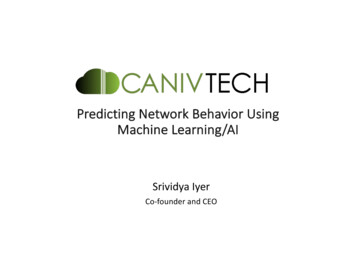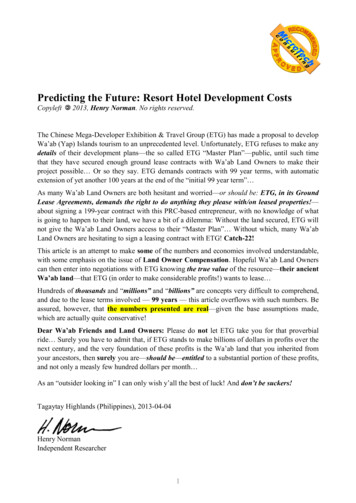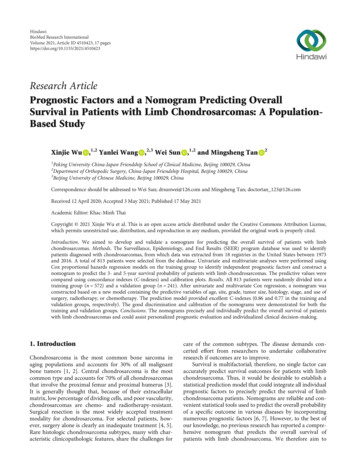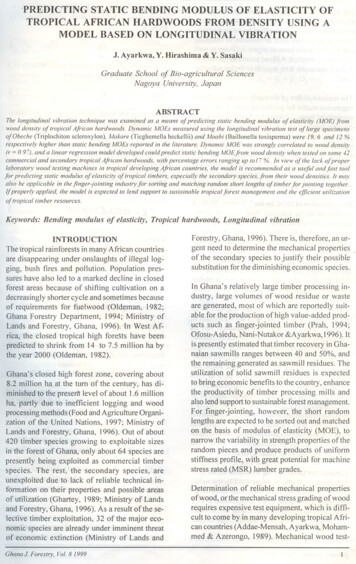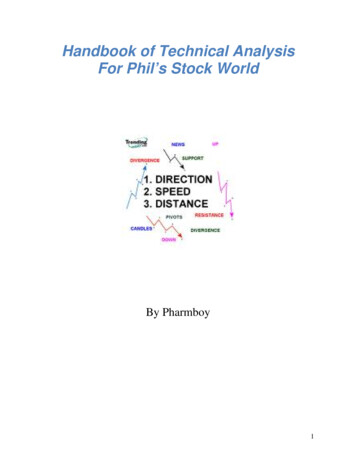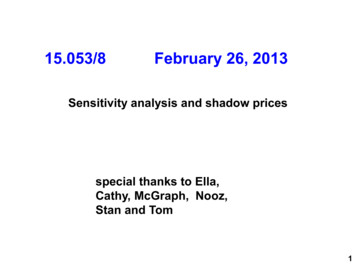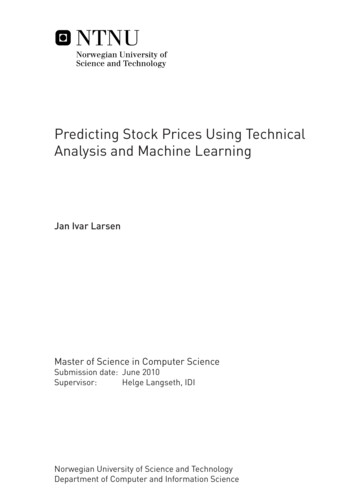
Transcription
Predicting Stock Prices Using TechnicalAnalysis and Machine LearningJan Ivar LarsenMaster of Science in Computer ScienceSubmission date: June 2010Supervisor:Helge Langseth, IDINorwegian University of Science and TechnologyDepartment of Computer and Information Science
Problem DescriptionIn this thesis, a stock price prediction model will be created using concepts and techniques intechnical analysis and machine learning. The resulting prediction model should be employed as anartificial trader that can be used to select stocks to trade on any given stock exchange. Theperformance of the model will be evaluated on stocks listed on the Oslo Stock Exchange.Assignment given: 15. January 2010Supervisor: Helge Langseth, IDI
AbstractHistorical stock prices are used to predict the direction of future stock prices. Thedeveloped stock price prediction model uses a novel two-layer reasoning approach thatemploys domain knowledge from technical analysis in the first layer of reasoning to guidea second layer of reasoning based on machine learning. The model is supplemented by amoney management strategy that use the historical success of predictions made by themodel to determine the amount of capital to invest on future predictions. Based on anumber of portfolio simulations with trade signals generated by the model, we concludethat the prediction model successfully outperforms the Oslo Benchmark Index (OSEBX).
PrefaceThis report constitutes my master thesis, written and implemented during the 10thsemester of the Master of Science studies in Computer Science at the Norwegian University of Science and Technology (NTNU). The work was initiated and executed at theDepartment of Computer and Information Science (IDI), Division of Intelligent Systems(DIS), starting on 15th of January 2010 and ending on 15th of June 2010.The problem description was conceptualized in cooperation with my professor andsupervisor Helge Langseth. I am grateful and humbled by the time and effort Langsethhas devoted to supervising the project, and his enthusiasm for offering advice, supportand feedback has been an inspiration and significantly increased the quality and extentof the work.Trondheim, June 15, 2010.Jan Ivar Larsen
Contents1 Introduction1.1 Purpose . . . . . . .1.2 Scope . . . . . . . .1.3 The Dataset . . . . .1.4 Success Criteria . . .1.5 Document Structure.1123342 Background and Rationale52.1 Trading Basics . . . . . . . . . . . . . . . . . . . . . . . . . . . . . . . . . 52.2 Technical Analysis . . . . . . . . . . . . . . . . . . . . . . . . . . . . . . . 82.3 Related Research . . . . . . . . . . . . . . . . . . . . . . . . . . . . . . . . 113 Feature Generation3.1 Trend Agent . . . . . . . .3.2 Moving Average Crossover3.3 Candlestick Agent . . . .3.4 Stochastic Agent . . . . .3.5 Volume Agent . . . . . . .3.6 ADX Agent . . . . . . . . . . .Agent. . . . . . . . . . . . .151622262931324 Feature Aggregation354.1 The Learning Problem . . . . . . . . . . . . . . . . . . . . . . . . . . . . . 354.2 Agent Decision Trees . . . . . . . . . . . . . . . . . . . . . . . . . . . . . . 374.3 Evolving Decision Trees . . . . . . . . . . . . . . . . . . . . . . . . . . . . 395 Portfolio and Money Management515.1 Money Management . . . . . . . . . . . . . . . . . . . . . . . . . . . . . . 515.2 Portfolio Simulations . . . . . . . . . . . . . . . . . . . . . . . . . . . . . . 546 Results and Discussion576.1 Feature Generation Results . . . . . . . . . . . . . . . . . . . . . . . . . . 586.2 Feature Aggregation Results . . . . . . . . . . . . . . . . . . . . . . . . . . 626.3 Money Management Results . . . . . . . . . . . . . . . . . . . . . . . . . . 677 Conclusion73Bibliography76Appendix A Stocks79Appendix B Candlestick Patterns81
1IntroductionForecasting the direction of future stock prices is a widely studied topic in many fieldsincluding trading, finance, statistics and computer science. The motivation for which isnaturally to predict the direction of future prices such that stocks can be bought and soldat profitable positions. Professional traders typically use fundamental and/or technicalanalysis to analyze stocks and make investment decisions. Fundamental analysis is thetraditional approach involving a study of company fundamentals such as revenues andexpenses, market position, annual growth rates, and so on (Murphy, 1999). Technicalanalysis, on the other hand, is solely based on the study of historical price fluctuations.Practitioners of technical analysis study price charts for price patterns and use pricedata in different calculations to forecast future price movements (Turner, 2007). Thetechnical analysis paradigm is thus that there is an inherent correlation between priceand company that can be used to determine when to enter and exit the market .In finance, statistics and computer science, most traditional models of stock priceprediction use statistical models and/or neural network models derived from price data(Park and Irwin, 2007). Moreover, the dominant strategy in computer science seems tobe using evolutionary algorithms, neural networks, or a combination of the two (evolvingneural networks). The approach taken in this thesis differ from the traditional approachin that we use a knowledge-intensive first layer of reasoning based on technical analysisbefore applying a second layer of reasoning based on machine learning. The first layer ofreasoning thus performs a coarse-grained analysis of the price data that is subsequentlyforwarded to the second layer of reasoning for further analysis. We hypothesis that thisknowledge-intensive coarse-grained analysis will aid the reasoning process in the secondlayer as the second layer can then focus on the quintessentially important aspects of theprice data rather than the raw price data itself.1.1PurposeThe purpose of the thesis is to create a stock price prediction model for the Oslo StockExchange. The resulting model is intended to be used as a decision support tool or asan autonomous artificial trader if extended with an interface to the stock exchange. Ahigh-level system overview of the developed stock price prediction model is presented inFigure 1.1.Figure 1.1: The Stock Price Prediction Model1
The developed model employs a two-layer reasoning approach. The first reasoning layeris a knowledge-intensive Feature Generation module based on domain knowledge fromtechnical analysis and certain other statistical tools. This is implemented by a set ofartificial agents where each agent employs a specific subset of expertise from technicalanalysis. The resulting output is a set of quintessentially important feature-values derivedfrom the price data (such as price is trending up, a trend reversal is expected to occur, thestock is trading on high volume, etc.). The generated feature-values are then forwardedto the second layer of reasoning called the Feature Aggregation module. In the FeatureAggregation module machine learning is employed to learn a classification model thataggregate and place the derived feature-values in context of each other. The resultingoutput is an investment strategy that can be used to select stocks to trade on the OsloStock Exchange. In the Portfolio and Money Management module the performance ofthe investment strategy is evaluated in terms of profitability by simulating portfolio runsusing trade signals generated by the investment strategy. Moreover, the module includesa money management strategy used to assess the strength (i.e., confidence) of generatedpredictions and to determine the amount of capital to invest on a generated trade signal.1.2ScopeOur goal with the Feature Generation module is to provide a knowledge-intensive andcomputationally efficient coarse-grained analysis of historical prices which can be analyzedfurther in a second layer of reasoning. The domain knowledge implemented in the moduleis thus limited to methods and techniques in technical analysis. The technical analysisliterature includes a wealth of different stock analysis techniques, some of which involvecomplicated and intricate price patterns subjective in both detection and interpretation.These methods would be both computationally expensive to detect and evaluate, and haveconsequently been disregarded. We thus apply Occam’s razor to the choice of methodsin technical analysis, focusing on the most popular indicators that can be efficientlyoperationalized and are intuitive in interpretation.It may seem overly presumptuous to believe that historical price fluctuations alone canbe used to predict the direction of future prices. It may thus seem natural to includesome fundamental analysis knowledge in the feature generation process. However, due tothe inherent limitations in time and the added complexity of including a second analysistechnique, this has not been a priority. We have instead placed focus on creating a modelthat can be easily extended with new analysis techniques, not necessarily from technicalanalysis, by using two separate reasoning layers and using an agent-oriented approach forthe domain knowledge. The agent-oriented approach is explained in detail in Chapter 3.Although our goal in this thesis is not to justify, prove or disprove technical analysis, byfocusing strictly on technical indicators we are presented with an opportunity to evaluatethe utility of selected methods in this form of stock analysis.2
Figure 1.2: The Oslo Benchmark Index from 01-01-2005 to 01-04-2010. Notice the sharpdrop from mid-2008 to early 2009 resulting from the financial crisis.1.3The DatasetThe dataset available to learn and evaluate the performance of the implemented systemincludes daily historical prices available for the stocks currently listed on the OsloBenchmark Index (OSEBX). The Oslo Benchmark Index is a weighted index of arepresentative selection of the stocks listed on the Oslo Stock Exchange. All stocks listedon the index are easily transferable which makes our model easier to validate as wecan assume that selected stocks can be bought and sold at any time. The stocks usedare listed in Appendix A along with a Python script that can be used to download thedata from www.netfonds.no. The data used is all data available from 01-01-2005 to18-05-2010. The data is always separated in a training and test set where the separationpoint is configurable and will be noted in the report when needed. Although our focusin this thesis is on stocks listed on the Oslo Stock Exchange, the developed model canjust as easily be used for any other stock exchange where a sufficient amount of dailyhistorical prices are available.1.4Success CriteriaThe purpose of the thesis is to create a stock price prediction model that can be used as adecision support tool or as an autonomous artificial trader. The central research questionthus becomes, ”can we create a computer system that trades in stocks with performancecomparative to a professional trader”? The primary measure of success will thus be basedon executing portfolio runs that simulate transactions based on some initial investmentcapital (e.g., 100 000 NOK) and an investment strategy generated by the model. Theprofits generated by portfolio simulations on the model will be evaluated by comparingit against investing the entire initial investment capital in the Oslo Benchmark Index3
shown in Figure 1.2. If it is more profitable to use the developed stock price predictionmodel to select stocks to trade, we consider the model a success.1.5Document StructureThe remainder of this thesis document is organized in the following six chapters,Background and Rationale contains a non-technical overview of trading basics andtraditional stock analysis techniques including the rationale behind technical analysis.Feature Generation documents different methods in technical analysis and the firstlayer of reasoning including the agent population designed to execute the featuregeneration process.Feature Aggregation describes the second layer of reasoning based on machine learning, evolutionary algorithms and decision tree classification.Portfolio and Money Management describes the money management strategy andthe portfolio simulation procedure.Results and Discussion documents the results obtained by testing the developedmodel on stocks listed on the Oslo Stock Exchange.Conclusion contains concluding remarks and points for future work.4
2Background and RationaleIn this chapter the basics of stock markets, trading, and general price prediction techniquesare introduced. The primary focus will be on the fundamentals that govern stock marketsand the chosen stock analysis technique; technical analysis. Our goal here is not togo into specific details of methods in technical analysis, but rather give an overviewof the underlying rationale in the field. Methods in technical analysis that have beenimplemented in the prediction model will be elaborated in Chapter 3. The chapter isconcluded with an overview of related research on operationalized technical analysis.Please note that most of the material presented in this chapter was initially researchedand written in a preliminary project (Larsen, 2009), and is presented here in succinctform for completeness and for readers unfamiliar with the preliminary project.2.1Trading BasicsTrading stocks is the process of buying and selling shares of a company on a stockexchange with the aim of generating profitable returns. The stock exchange operates likeany other economic market; when a buyer wants to buy some quantity of a particularstock at a certain price, there needs to be a seller willing to sell the stock at the offeredprice. Transactions in the stock market are
focusing strictly on technical indicators we are presented with an opportunity to evaluate the utility of selected methods in this form of stock analysis. 2. Figure 1.2: The Oslo Benchmark Index from 01-01-2005 to 01-04-2010. Notice the sharp drop from mid-2008 to early 2009 resulting from the financial crisis. 1.3 The Dataset The dataset available to learn and evaluate the performance of the .
